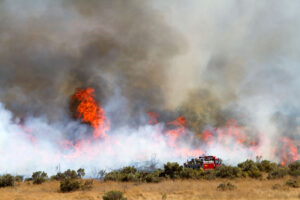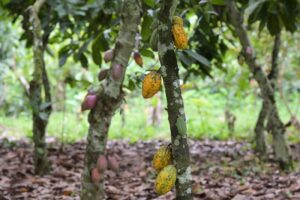A decline in the area burned globally by wildfires over the 20th century due to land-use change has almost entirely been offset by the increase caused by global warming, a new study says.
The paper, published in Nature Climate Change, is the first attribution study to assess the impacts of climate change and land-use change on “global burned area”.
It finds that changes in population distribution and land use over the 20th century – including forest fragmentation and the conversion of land for urban development and agriculture – have suppressed wildfires, driving down global burned area by 19%.
However, this decline has been hindered by human-caused warming, which has expanded the area burned by 16% through increasingly hot and dry conditions across much of the world.
As a result, the global burned area has declined just 5% over the past 100 years.
Despite the worldwide decline overall, the study finds that climate change has driven increases in burned area of 29% in south-eastern South America, 22% in northern Australia, 18% in west Siberia and 15% in western North America.
This study is the “key missing piece to the puzzle of tracking anthropogenic emissions”, according to Dr Matthew Jones – an independent researcher who was not involved in the study.
Jones, who works with on the annual Global Carbon Budget (GCP), tells Carbon Brief that this study is a “major step forward in modelling the extent of additional, human-related fires”. He notes that until now, projects like the GCB have “been forced to assume that all fire emissions are natural, therefore underestimating the effect of people on the global carbon cycle”.
Burned area paradox
Australia’s “black summer” bushfires of 2020-21 are one of the continent’s most intense and damaging fire seasons on record. The fires burned around almost 25m hectares of land, killed more than 30 people and released more CO2 than the combined annual emissions of over 100 countries.

Researchers from the World Weather Attribution (WWA) service published a “rapid attribution” study on Australia’s wildfires. They find the likelihood of Australia experiencing weather conditions like those in the lead-up to its 2020-21 fires has increased by at least 30% since 1900 as a result of climate change.
Similarly, WWA found that climate change more than doubled the likelihood of extreme fire weather conditions that led to unprecedented fires in eastern Canada in 2023. And the hot, dry and windy conditions that drove the devastating Pantanal wildfires in 2024 were 40% more intense due to climate change.
Attribution studies make it clear that climate change is making individual wildfires more intense and frequent. However, data shows that, overall, the area burned globally by fires is decreasing.
Dr Matthew Jones is an independent researcher who works with the Natural Environment Research Council and Global Carbon Project. He is the lead author of a study published last week, which finds that forest fire carbon emissions increased by 60% globally over 2001-23.
He tells Carbon Brief there climate change is does not provide the whole picture when it comes to global burned area, noting that human activity can impact wildfires in many ways:
“Wildfires are a natural phenomenon, but they are made increasingly likely by human-induced climate change and they are also influenced by people, who manage much of Earth’s land area and also alter rates of fire ignition.
“Fire scientists have long grappled with the troublesome task of separating out the additional fires that people are causing, over and above the fires that would have happened naturally.”
Attributing burned area
Seppe Lampe is a doctoral student at Vrije University Brussels department of water and climate and co-lead author on the study. He tells Carbon Brief that “this is the first study that actually attributes and quantifies how much climate change has affected burned area all over the world”.
The authors use seven “fire-vegetation models” from the Inter-Sectoral Impact Model Intercomparison Project to carry out the attribution study, which compares wildfires in today’s climate with wildfires in a counterfactual world without human-caused climate change.
To assess the impact of climate change on global burned area, the authors run models of the present-day climate (2003-19), both with and without the impacts of climate change. They then compare the results to isolate the impacts of climate change on global burned area.
To study the impact of “direct human forcing” – defined as land-use change, land management and population density – they compare simulations of the world in the early-industrial period (1901-17) and a present day world (2003-19) without the impact of climate change. In these simulations, the authors do not include any long-term changes in climate, so the only differences are in land use and population change.
The maps below show the percentage change in burned area due to climate change (top), direct human forcing (middle) and both (bottom). Red indicates an increase in percentage burned area and blue indicates a decrease. White indicates that there has been little change in the percentage of burned area. The map divides the world into hexagonal regions, as used by the Intergovernmental Panel on Climate Change (IPCC).

Climate and land-use change
The study finds that climate change has driven an increase in burned area in most IPCC regions, with only eight of the 42 regions showing a decrease in burned area due to the changing climate.
Lampe explains that the climate-driven decrease in burned area in regions such as south-east Asia could be due to factors such as changing rainfall patterns.
Many regions have seen more than a 10% increase in burned area due to climate change alone, including all IPCC regions in Australia and several regions in South America, Siberia and North America, the study adds.
The authors find that on average, climate change has driven a 16% increase in burned area globally and increased the probability of experiencing months with above-average global burned area by 22%.
The area of land that would be burned in the two most-active fire months of the year in a world without climate change is now expected for four months every year, the authors add.
The authors also find that the impact of climate change on burned area is accelerating over time, increasing most rapidly after the 1970s. Central Australia has seen the greatest increase.
Conversely, the authors find that changes in direct human forcing factors since the early industrial period have driven a 19.1% decrease in burned area.
This is due to landscape fragmentation, a reduction in fuel for fires – often seen when landscapes are converted from natural areas into urban areas or cropland – and deliberate fire management and suppression techniques, according to the study.
The decrease in burned area is mainly seen in savannah, grasslands and croplands – particularly in equatorial Asia and tropical North Africa – Lampe tells Carbon Brief. He adds:
“The global signal of burned area is actually 70% determined by what’s going on in the African savannahs. And there we see more and more savannahs being turned into cropland, which causes a decline in burned area.”
Overall, the study finds a 5% reduction in global burned area since the early 20th century.
‘Major step forward’
The study shows that without the “mitigating influences” of land-use change, global burned area would probably be even higher today.
This work is a “major step forward in modelling the extent of additional, human-related fires”, Jones tells Carbon Brief. He adds:
“Up until now, projects like the Global Carbon Budget have struggled to estimate how people influence the climate through wildfire emissions. We have been forced to assume that all fire emissions are natural, therefore underestimating the effect of people on the global carbon cycle.”
He explains that this study is the “key missing piece to the puzzle of tracking anthropogenic emissions”.
Prof David Bowman is an Australian Research Council laureate fellow and the director of the transdisciplinary Fire Centre at the University of Tasmania. He tells Carbon Brief that the approach used in this study seems “valid”, but adds that wildfire modelling is “extraordinarily difficult”.
He points out a few important assumptions and caveats in the “useful” study – for example, that the authors do not consider the intensity of fires.
Bowman also warns that the decline in global burned area “has been used for political purposes deflecting attention from the escalating wildfire crisis”.
Dr Maria Barbosa – a researcher at the Universidade Federal de São Carlos, who was not involved in the study – tells Carbon Brief that the study “provides valuable insights into how fire regimes are likely to shift”.
Barbosa warns that “we are currently failing to prepare for the upcoming fire seasons”, and says that governments need to invest in early warning systems, improve land-use planning to reduce fire risks and strengthen policies for forest management and restoration.
Lampe tells Carbon Brief that the findings of this study could help to inform regional policymakers and could “have significance for loss and damage”.
The post Climate change almost wipes out decline in global area burned by wildfires appeared first on Carbon Brief.
Climate change almost wipes out decline in global area burned by wildfires
Greenhouse Gases
DeBriefed 3 October 2025: UK political gap on climate widens; Fossil-fuelled Typhoon Ragasa; ‘Overshoot’ unknowns
Welcome to Carbon Brief’s DeBriefed.
An essential guide to the week’s key developments relating to climate change.
This week
Shattered climate consensus
FRACKING BAN: UK energy secretary Ed Miliband has announced that the government will bring forward its plans to permanently ban fracking, in a move designed to counter a promise from the hard-right Reform party to restart efforts to introduce the practice, the Guardian said. In the same speech, Miliband said Reform’s plans to scrap clean-energy projects would “betray” young people and future generations, the Press Association reported.
ACT AXE?: Meanwhile, Kemi Badenoch, leader of the Conservatives, pledged to scrap the 2008 Climate Change Act if elected, Bloomberg reported. It noted that the legislation was passed with cross-party support and strengthened by the Conservatives.
‘INSANE’: Badenoch faced a backlash from senior Tory figures, including ex-prime minister Theresa May, who called her pledge a “catastrophic mistake”, said the Financial Times. The newspaper added that the Conservatives were “trailing third in opinion polls”. A wide range of climate scientists also condemned the idea, describing it as “insane”, an “insult” and a “serious regression”.
Around the world
- CLIMATE CRACKDOWN: The US Department of Energy has told employees in the Office of Energy Efficiency and Renewable Energy to avoid using the term “climate change”, according to the Guardian.
- FOREST DELAY: Plans for Brazil’s COP30 flagship initiative, the tropical forests forever fund, are “suffer[ing] delays” as officials remain split on key details, Bloomberg said.
- COP MAY BE ‘SPLIT’: Australia could “split” the hosting of the COP31 climate summit in 2026 under a potential compromise with Turkey, reported the Guardian.
- DIVINE INTERVENTION: Pope Leo XIV has criticised those who minimise the “increasingly evident” impact of global warming in his first major climate speech, BBC News reported.
€44.5 billion
The cost of extreme weather and climate change in the EU in the last four years – two-and-a-half times higher than in the decade to 2019, according to a European Environment Agency report covered by the Financial Times.
Latest climate research
- Fossil-fuelled climate change caused around 36% of Typhoon Ragasa’s direct damage to homes and properties in southern China, according to a rapid impact attribution study | Imperial Grantham Institute – Climate Change and the Environment
- Some 86% of the global population are concerned about climate change, according to a survey of 280,000 people in 142 countries and regions | Climate Policy
- A global shift towards a “planetary health diet” could slash emissions and save tens of thousands of lives each day | EAT-Lancet Commission 2025 report
(For more, see Carbon Brief’s in-depth daily summaries of the top climate news stories on Monday, Tuesday, Wednesday, Thursday and Friday.)
Captured
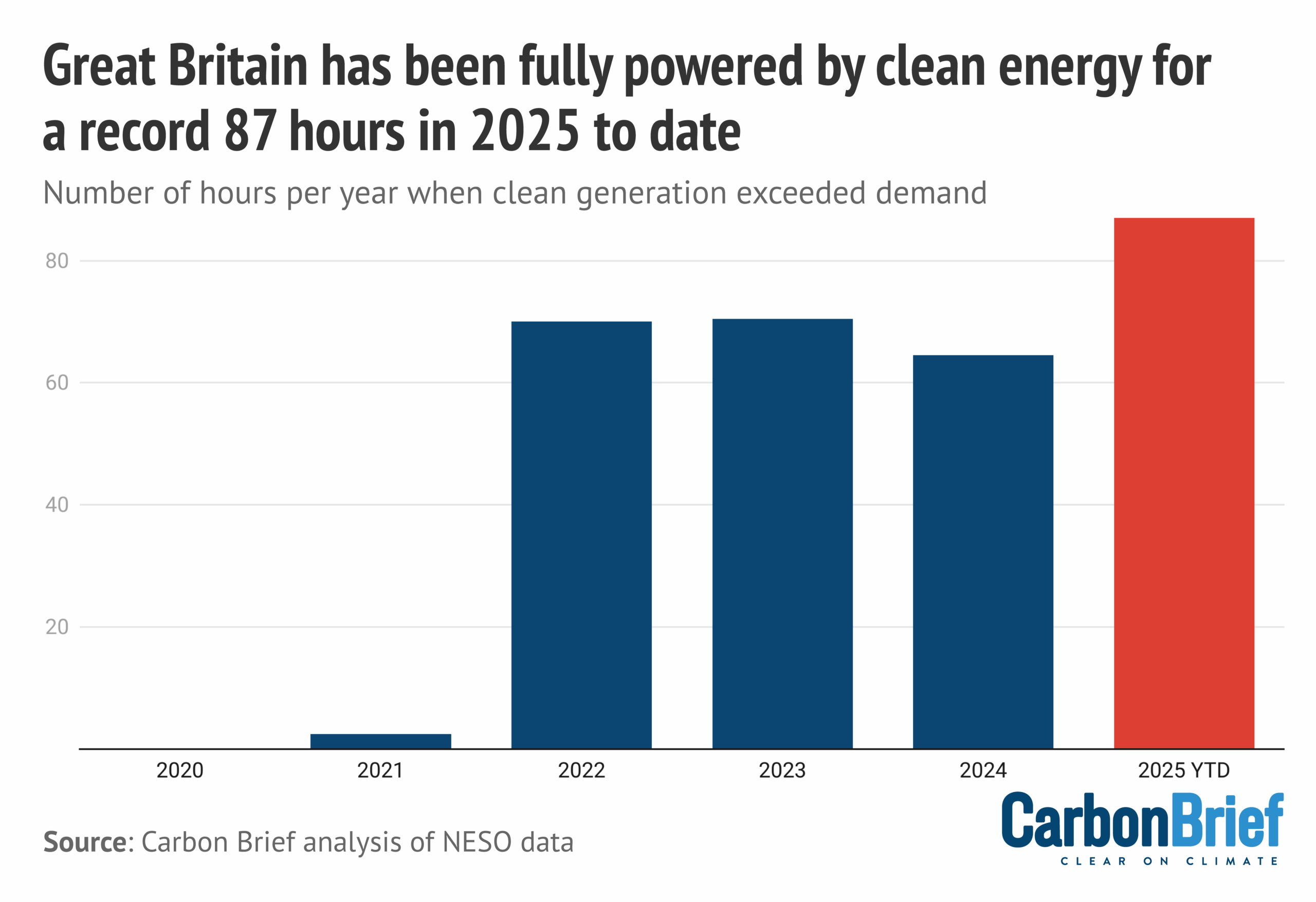
Clean energy has met 100% of Great Britain’s electricity demand for a record 87 hours this year so far, according to new Carbon Brief analysis. This is up from just 2.5 hours in 2021 and 64.5 hours in all of 2024. The longest stretch of time where 100% of electricity demand was met by clean energy stands at 15 hours, from midnight on 25 May 2025 through to 3pm on 26 May, according to the analysis.
Spotlight
‘Overshoot’ unknowns
As the chances of limiting global warming to 1.5C dwindle, there is increasing focus on the prospects for “overshooting” the Paris Agreement target and then bringing temperatures back down by removing CO2 from the atmosphere.
At the first-ever Overshoot Conference in Laxenburg, Austria, Carbon Brief asks experts about the key unknowns around warming “overshoot”.
Sir Prof Jim Skea
Chair of the Intergovernmental Panel on Climate Change (IPCC) and emeritus professor at Imperial College London’s Centre for Environmental Policy
So there are huge knowledge gaps around overshoot and carbon dioxide removal (CDR). As it’s very clear from the themes of this conference, we don’t altogether understand how the Earth would react in taking CO2 out of the atmosphere.
We don’t understand the nature of the irreversibilities and we don’t understand the effectiveness of CDR techniques, which might themselves be influenced by the level of global warming, plus all the equity and sustainability issues surrounding using CDR techniques.
Prof Kristie Ebi
Professor at the University of Washington’s Center for Health and the Global Environment
There are all kinds of questions about adaptation and how to approach effective adaptation. At the moment, adaptation is primarily assuming a continual increase in global mean surface temperature. If there is going to be a peak – and of course, we don’t know what that peak is – then how do you start planning? Do you change your planning?
There are places, for instance when thinking about hard infrastructure, [where overshoot] may result in a change in your plan – because as you come down the backside, maybe the need would be less. For example, when building a bridge taller. And when implementing early warning systems, how do you take into account that there will be a peak and ultimately a decline? There is almost no work in that. I would say that’s one of the critical unknowns.
Dr James Fletcher
Former minister for public service, sustainable development, energy, science and technology for Saint Lucia and negotiator at COP21 in Paris.
The key unknown is where we’re going to land. At what point will we peak [temperatures] before we start going down and how long will we stay in that overshoot period? That is a scary thing. Yes, there will be overshoot, but at what point will that overshoot peak? Are we peaking at 1.6C, 1.7C, 2.1C?
All of these are scary scenarios for small island developing states – anything above 1.5C is scary. Every fraction of a degree matters to us. Where we peak is very important and how long we stay in this overshoot period is equally important. That’s when you start getting into very serious, irreversible impacts and tipping points.
Prof Oliver Geden
Senior fellow and head of the climate policy and politics research cluster at the German Institute for International and Security Affairs and vice-chair of IPCC Working Group III
[A key unknown] is whether countries are really willing to commit to net-negative trajectories. We are assuming, in science, global pathways going net-negative, with hardly any country saying they want to go there. So maybe it is just an academic thought experiment. So we don’t know yet if [overshoot] is even relevant. It is relevant in the sense that if we do, [the] 1.5C [target] stays on the table. But I think the next phase needs to be that countries – or the UNFCCC as a whole – needs to decide what they want to do.
Prof Lavanya Rajamani
Professor of international environmental law at the University of Oxford
I think there are several scientific unknowns, but I would like to focus on the governance unknowns with respect to overshoot. To me, a key governance unknown is the extent to which our current legal and regulatory architecture – across levels of governance, so domestic, regional and international – will actually be responsive to the needs of an overshoot world and the consequences of actually not having regulatory and governance architectures in place to address overshoot.
Watch, read, listen
FUTURE GAZING: The Financial Times examined a “future where China wins the green race”.
‘JUNK CREDITS’: Climate Home News reported on a “forest carbon megaproject” in Zimbabwe that has allegedly “generated millions of junk credits”.
‘SINK OR SWIM’: An extract from a new book on how the world needs to adapt to climate change, by Dr Susannah Fisher, featured in Backchannel.
Coming up
- 7 October: International Energy Agency (IEA) renewables 2025 report launch
- 8-10 October: World summit of Indigenous peoples and nature, Abu Dhabi, UAE
- 9-15 October: International Union for the Conservation of Nature (IUCN) 2025 congress, Abu Dhabi, UAE
Pick of the jobs
- UK government foreign, commonwealth and development office, senior climate policy adviser | Salary: CA$93,207. Location: Calgary, Canada
- Wellcome Trust, senior research manager, climate and health | Salary: £64,800. Location: London
- Bloomberg, product manager – climate, nature and sustainability regulations | Salary: Unknown. Location: London
DeBriefed is edited by Daisy Dunne. Please send any tips or feedback to debriefed@carbonbrief.org.
This is an online version of Carbon Brief’s weekly DeBriefed email newsletter. Subscribe for free here.
The post DeBriefed 3 October 2025: UK political gap on climate widens; Fossil-fuelled Typhoon Ragasa; ‘Overshoot’ unknowns appeared first on Carbon Brief.
Greenhouse Gases
Q&A: What the ‘controversial’ GWP* methane metric means for farming emissions
A controversial way of measuring how much methane warms the planet has stirred debate in recent years – particularly around assessing the climate impact of livestock farming.
The metric – known as GWP* (global warming potential star) – was designed to more precisely account for the warming impact of short-lived greenhouse gases, such as methane.
No country so far has used GWP* to measure emissions, but New Zealand is currently considering its use.
In June, a group of climate scientists from around the world wrote an open letter advising against this.
They argued that the metric “creates the expectation that current high levels of methane emissions are allowed to continue”.
Climate experts tell Carbon Brief that there is “no strong debate” on the science behind GWP* and that it can accurately assess the global warming effect of methane.
But many experts also firmly caution against its use in national climate targets, believing it could allow countries to prolong high levels of emissions at a time when they should be drastically cut.
Some researchers tell Carbon Brief that GWP* is an “accounting trick” and a “get-out-of-jail-free card for methane emitters”. A 2021 Bloomberg article called the metric “fuzzy methane math”.
Prof Myles Allen, one of the scientists who created GWP*, tells Carbon Brief that the metric is “nothing more” than one way of better understanding the climate impact of different actions as part of efforts to limit warming under the Paris Agreement.
In this Q&A, Carbon Brief explains the science behind GWP*, why the metric is so divisive and the ways in which its use has been considered.
- What is GWP*?
- What are the main controversies around using GWP*?
- Do any countries currently use GWP* to measure methane emissions?
- What do experts think about the use of GWP*?
What is GWP*?
Global warming is caused by a build up of greenhouse gases – mainly from burning fossil fuels – trapping heat in the atmosphere.
Different gases cause differing levels of warming and remain in the atmosphere for varying lengths of time. For example, carbon dioxide (CO2), the main contributor to warming, lingers for centuries, whereas other gases last decades or even millennia.
To account for these variables, scientists use a metric known as global warming potential (GWP), which assesses the warming caused by different gases compared to CO2, which has a GWP of 1.
Using GWP, emissions of other gases are calculated in terms of their “CO2 equivalent” over a given amount of time.
In their reports, the Intergovernmental Panel on Climate Change (IPCC) set out three GWP variants measured over 20 years (GWP20), 100 years (GWP100) and 500 years (GWP500).
GWP100 is the most common approach and is used to calculate emissions under the Paris Agreement.
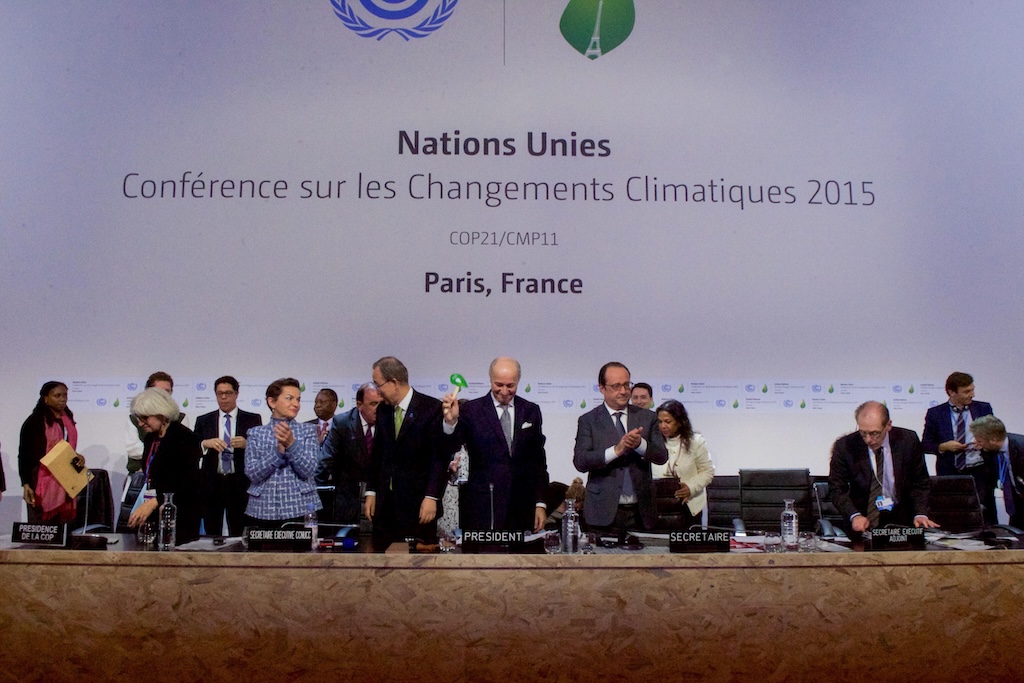
Methane is a short-lived gas that only remains in the atmosphere for around 12 years before breaking down. But it causes a large burst of initial warming that is around 80 times more powerful than CO2, according to the IPCC.
This means that one tonne of methane causes the same amount of warming as around 80 tonnes of CO2, when measured over a period of 20 years.
When calculated over 100 years, methane’s shorter lifetime means it causes around 30 times more warming than CO2.
Some experts have criticised the use of GWP100, saying it does not sufficiently account for the fact that methane leaves the atmosphere much more quickly than CO2 and does not actually last for 100 years. This is the issue that GWP* was designed to fix.
GWP* calculates the warming contributions of long- and short-lived gases at different rates, accounting for their varying lifetimes in the atmosphere.
One of the researchers behind GWP*, Dr Michelle Cain, explained in a 2018 Carbon Brief guest post that a constant rate of methane emissions can maintain stable atmospheric concentrations of the gas, assuming methane sinks remain constant as well.
In contrast, a constant rate of CO2 emissions “leads to year-on-year increases in warming, because the CO2 accumulates in the atmosphere”, Cain wrote. CO2 does not leave the atmosphere after a decade or so, as methane does, and continues to build over time until emissions stop.
Cain, formerly a researcher at the University of Oxford and now a senior lecturer at Cranfield University, added:
“For countries with high methane emissions – due to, say, agriculture – this can make a huge difference to how their progress in emission reductions is judged.”
Methane emissions that slowly decline or remain stable over time are calculated as contributing “no additional warming” to the planet, which is not the case with other GWP calculations.
The chart below shows simplified emissions scenarios for CO2 and methane, highlighting the different impacts they have on global warming over time.
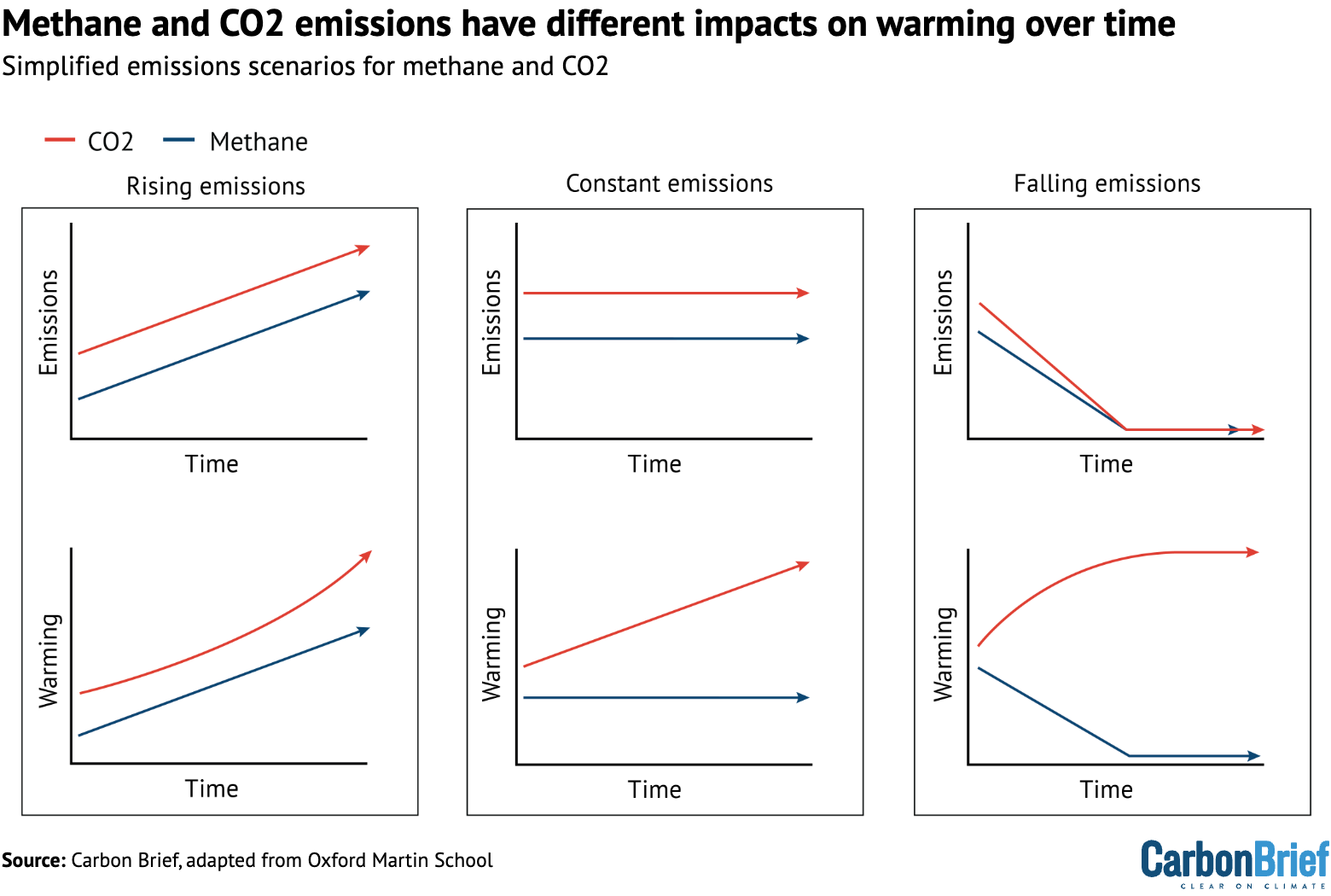
The chart below shows how using the two different metrics – GWP* and GWP100 – affects the same emissions pathway throughout the 21st century, given the different warming impacts of greenhouse gases.

If, for example, a country emitted 4m tonnes of methane annually from 1990-2005, these emissions would now be considered “climate-neutral” using GWP*, as they are not actively contributing new warming to the atmosphere, but rather maintaining the existing levels of methane in the atmosphere in 1990.
This would not be the case under GWP100, which looks at the warming potential of emissions over the course of a century and does not account for their different atmospheric lifetimes.
GWP* can be used for other short-lived gases, such as some hydrofluorocarbons, but methane is the most significant short-lived gas when it comes to climate change.
The IPCC notes that converting methane emissions into CO2 equivalent using GWP100 “overstates the effect of constant methane emissions on global surface temperature by a factor of 3-4” and understates the impact of new methane emissions “by a factor of 4-5 over the 20 years following the introduction of the new source”.
GWP* was created by several researchers, including Prof Myles Allen, the head of atmospheric, oceanic and planetary physics at the University of Oxford. The concept was detailed in a 2016 study and first named in a 2018 study. It was further updated by the authors in 2019 and 2020.
Allen tells Carbon Brief that the researchers involved were “reluctant” to give their new metric a name, as it “was just a way of using reported numbers to calculate warming impact”. He adds:
“I think it’s really unfortunate that people have latched onto GWP*. It doesn’t matter. We could forget about GWP* entirely, we can just use a climate model to work out the warming impact…GWP* is a handy way of calculating the warming impact of activities. Nothing more.”
What are the main controversies around using GWP*?
Efforts to cut methane emissions are widely viewed as a “quick-win” to help limit the effects of climate change in the short term.
More than 100 countries signed a pledge, launched at COP26 in 2021, to cut global methane emissions by 30% by 2030.
Cutting methane would also help to counteract an acceleration in warming due to declining aerosol emissions, which are currently masking around half a degree of warming.
Experts Carbon Brief spoke to agree on the importance of cutting methane emissions, but disagree on whether GWP* helps or hinders these efforts.
The debate around the metric centres on the possible impacts of its use, rather than the soundness of the science behind it.
Prof Joeri Rogelj, a climate science and policy professor at Imperial College London, explains:
“At the global level, at any level, the method of GWP* actually provides a good, new way to translate the trajectory of methane emissions into equivalent emissions of CO2, or emissions of CO2 that would have an equivalent warming effect…The debate is on the application.”
Allen says he is a “little frustrated” that discussions around the use of GWP* have “become so emotive”. He tells Carbon Brief:
“Every action we take has both a temporary impact on global temperature and a permanent one. How much is in both areas depends on the action. We need to know those two things in order to make decisions about choices of action in pursuit of a temperature goal…GWP* gives you a handy way of doing that.”
Below, Carbon Brief details some of the main discussion points and controversies around GWP*.
Carbon cycle
A misleading claim frequently made about livestock is that cows do not contribute much to global warming because the methane they emit eventually returns to the land through the carbon cycle – the set of processes in which carbon is exchanged between the atmosphere, land and ocean, as well as the organisms they contain.
Those in favour of using GWP* to measure methane emissions often also stress the difference between methane emissions that come from animals – known as biogenic methane – and methane from fossil fuels.
Rogelj tells Carbon Brief that biogenic and fossil-sourced methane are “slightly different, but that difference is really second-order” when it comes to climate change.
Methane warms the planet while it is in the atmosphere, so the “climate effect is exactly the same, irrespective of which source the methane comes from”, Rogelj adds.
The differences become more significant when methane breaks down in the atmosphere and oxidises into water vapour and CO2.
CO2 that originated from a cow can be reabsorbed by plants and the land. But the CO2 resulting from fossil methane – which stems from sources such as flaring from oil and gas drilling – stays in the atmosphere. Although fossil methane has a “bit of a longer effect”, Rogelj says:
“This is a bit of a red herring, because the main effect is, of course, the effect that the methane has while it is methane and not what the carbon molecule of that methane has after [the] methane has been broken down or oxidised to CO2.”
He adds that there are ways of reducing agricultural methane, such as “diet change” or “management measures”, but no way to remove the emissions “100%”.
The graphic below shows the digestive process through which a cow emits methane.
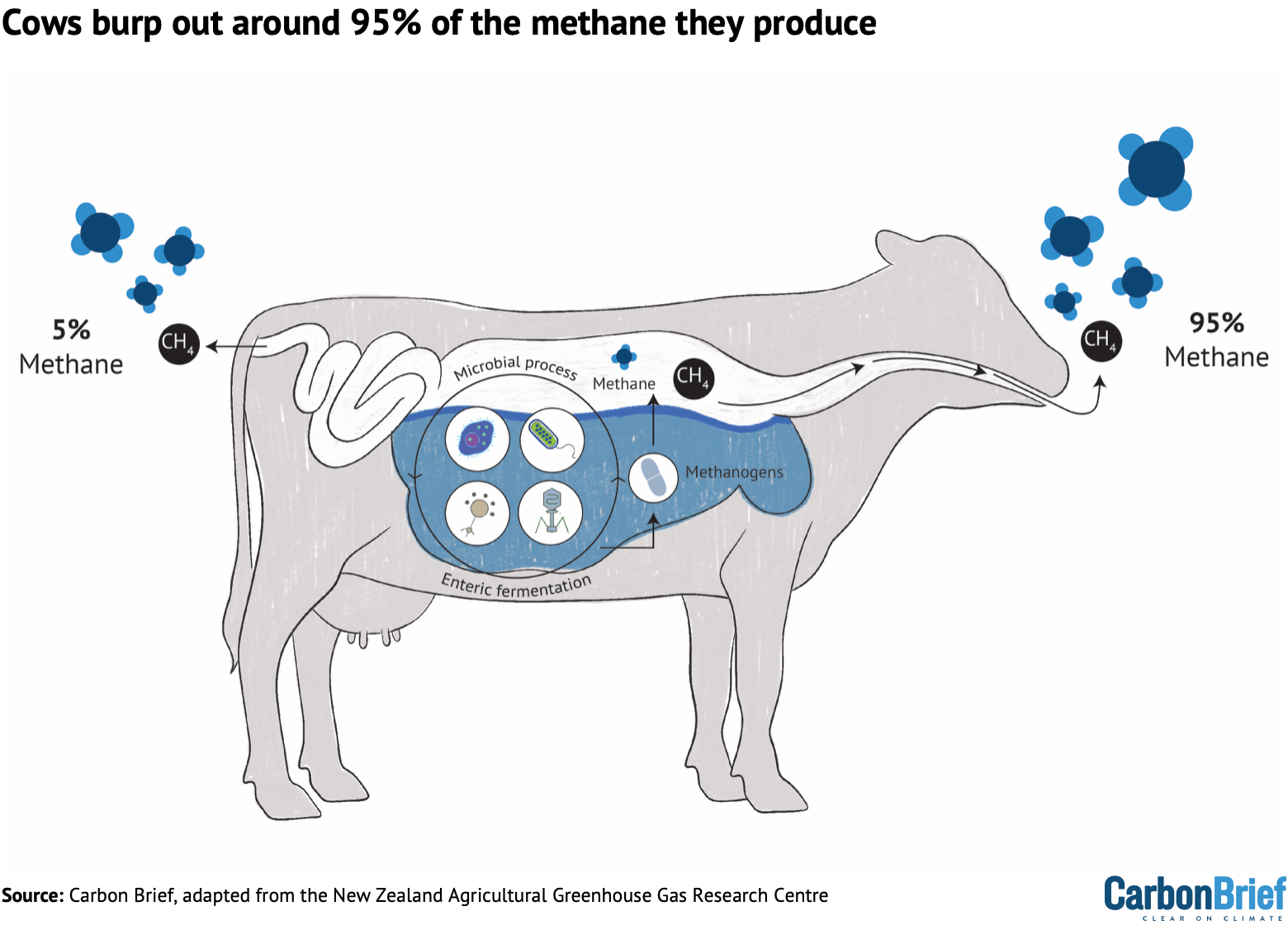
Agriculture also causes other significant environmental harms. It is responsible for around 80% of global deforestation and is a key driver of biodiversity loss and water pollution.
Prof Frank Mitloehner, a professor and air-quality specialist at the University of California, Davis (UC Davis), is one of the main proponents of GWP*, frequently speaking about it in public presentations and discussions with the farming sector.
He tells Carbon Brief that, while animal agriculture can cause environmental harm, it is a “silly argument” to say these impacts are being ignored in carbon-cycle discussions.
He gives an example of discussions on deaths from car accidents excluding mentions of the emissions from cars, saying that these wider impacts are still important and can be discussed separately.
He adds that it is an “urban myth” that biogenic methane emissions are not a concern because of the carbon cycle.
‘No additional warming’
Under GWP*, methane emissions stop causing new warming once they reduce by 10% over the course of 30 years – around 3% each decade, or 0.3% each year.
These emissions are then described in research and policy as causing “no additional warming”.
For example, a 2021 study from Mitloehner and other UC Davis researchers, found that methane emissions from the US cattle industry “have not contributed additional warming since 1986”, based on GWP* calculations. It also said that the dairy industry in California “will approach climate neutrality” by the 2030s, if methane emissions are cut by just 1% annually.
(According to the US Environmental Protection Agency, methane emissions from enteric fermentation – the digestive process through which cows produce the greenhouse gas – increased by more than 5% over 1990-2022.)
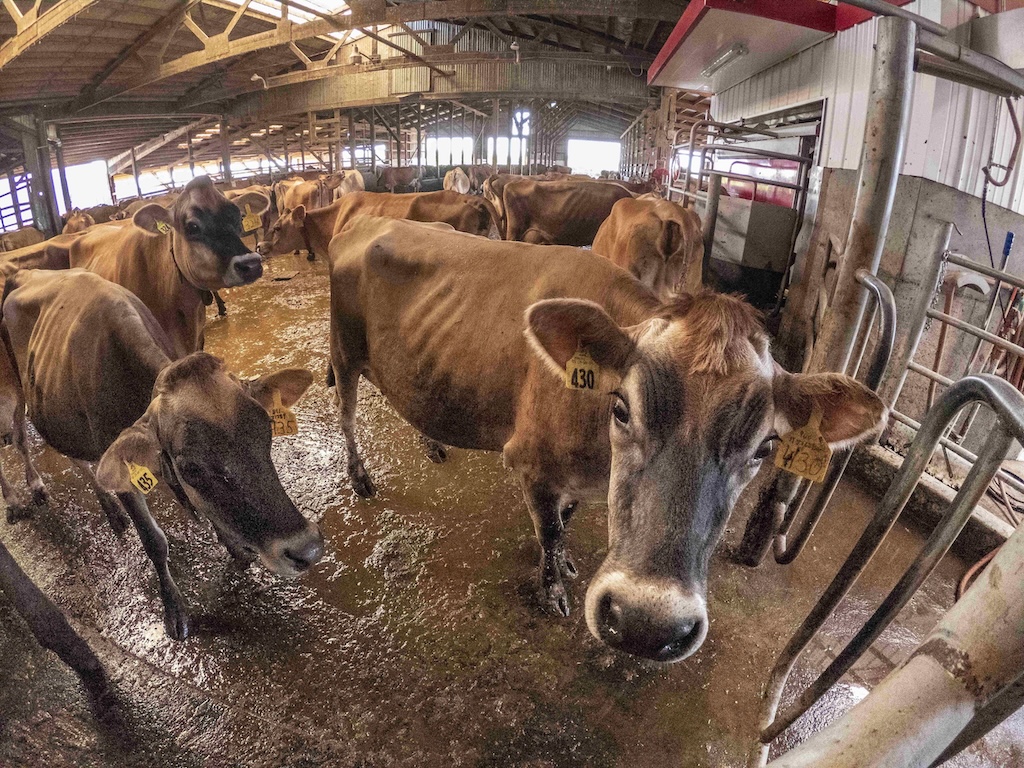
However, many critics take issue with the “no additional warming” concept.
The main criticism is that, although a gradually reducing herd of cattle may stabilise methane emissions, it still emits the polluting gas. If animal numbers were instead drastically reduced, this would cut methane emissions and lower warming rather than maintaining current levels.
Dr Caspar Donnison, a postdoctoral researcher at Lawrence Livermore National Laboratory in the US, says the term no additional warming is “absolutely misleading” in the context of GWP*. He tells Carbon Brief:
“You just assume, on the face of it, that this means it has a neutral impact on the climate…But ‘no additional warming’ means that you’re still sustaining the warming that the herd is causing.”
Allen says that the debate focuses on the “stock of warming versus additional warming”. He compares it to accounting for historical emissions of CO2:
“If a country got rich by burning CO2, they’ve caused a lot of warming in the past. If they reduce their CO2 emissions to zero, then people are generally happy to call what they’re doing climate-neutral, even though they may be sitting on a huge heap of historical warming caused by their CO2 emissions while they were burning [fossil fuels].
“And yet, temperature-wise, that’s exactly the same thing as having a source of methane that’s declining by 3% per decade.”
Climate ambition
Another criticism around the use of GWP* is that countries or companies with high agricultural methane emissions could use the metric to make small emission reductions appear larger.
Dr Donal Murphy-Bokern, an independent agricultural and environmental scientist, believes that the metric can be used as a “get-out-of-jail-free card for methane emitters”. He adds:
“It’s all about saying carry on as we are; we’ll manage this by slightly reducing our emissions over a critical period in history, so as to appear at that critical period in history to be so-called ‘climate-neutral’.”
Mitloehner disagrees with this, noting that, while reductions in methane emissions appear significant under GWP*, increases also appear significant. He says:
“It is simply not true that GWP* is a get-out-of-jail-free card. It’s not. If you reduce emissions, it makes your contributions look less. If you increase emissions, it makes your contributions much worse.”
Rogelj says he has not seen GWP* being used to advocate for the “highest possible ambition” in cutting methane emissions.
However, Allen says that “no metric tells you what to do”. He adds:
“How you measure emissions and how you measure warming has absolutely no bearing on whether you think a country has an obligation to undo some of the damage to the climate they’ve caused in the past.
“This is where the ‘free-pass’ argument makes no sense to me, because the existence of a method to calculate the warming impact of your emissions allows you to make decisions about emissions in light of their warming impact, sure, but it doesn’t tell you what the outcomes of those decisions should be.”
Allen adds that the livestock sector is “unsustainable globally”, with animal numbers and methane levels still rising.
The chart below shows how atmospheric methane concentrations have increased in recent decades.

Allen tells Carbon Brief:
“Do we need to eliminate livestock agriculture to stop global warming? No…[but] we do need to start decreasing it. And if we can decrease it faster than 3% per decade then that would help reduce warming that’s caused by other sectors or, indeed, undo some of the warming that the livestock sector has caused in the past.”
Mitloehner says considerations on the fairness of using GWP* are “real from a policy standpoint and they have to be addressed from a policy standpoint”. He adds:
“But, from a scientific standpoint – and that’s where I’m coming from – I think it’s not controversial.”
Baseline and historical emissions
The baseline year from which emissions reduction targets are set is significant, as it helps form the scope of climate ambition.
For example, high-emitting countries, such as the UK, have set 1990 as their baseline year for emissions-cutting targets, whereas many low-emitting countries may choose further back or more recent years, depending on their needs. Rogelj says:
“Because GWP* translates a change in emissions into either an instantaneous emission or instantaneous removal of CO2, your starting point becomes really important.
“If you start with very high emissions of methane and you did not in any way account for this high starting point, then even very minor, unambitious reductions in methane would result in creating credits for high-polluting countries.”
However, he notes that this is just one way of applying the metric and that there could be ways to avoid this “inequitable outcome”, such as applying GWP* globally and allocating each country a per-capita methane budget, instead of assessing based on national current or past emissions. (Rogelj and Prof Carl-Friedrich Schleussner discussed other possible GWP* equity measures in a 2019 study.)
The chart below, adapted from that study, shows how GWP* can significantly change the per-capita methane emissions of different countries. Some countries with high agricultural methane emissions, such as New Zealand, change from high to low per-capita emitters.
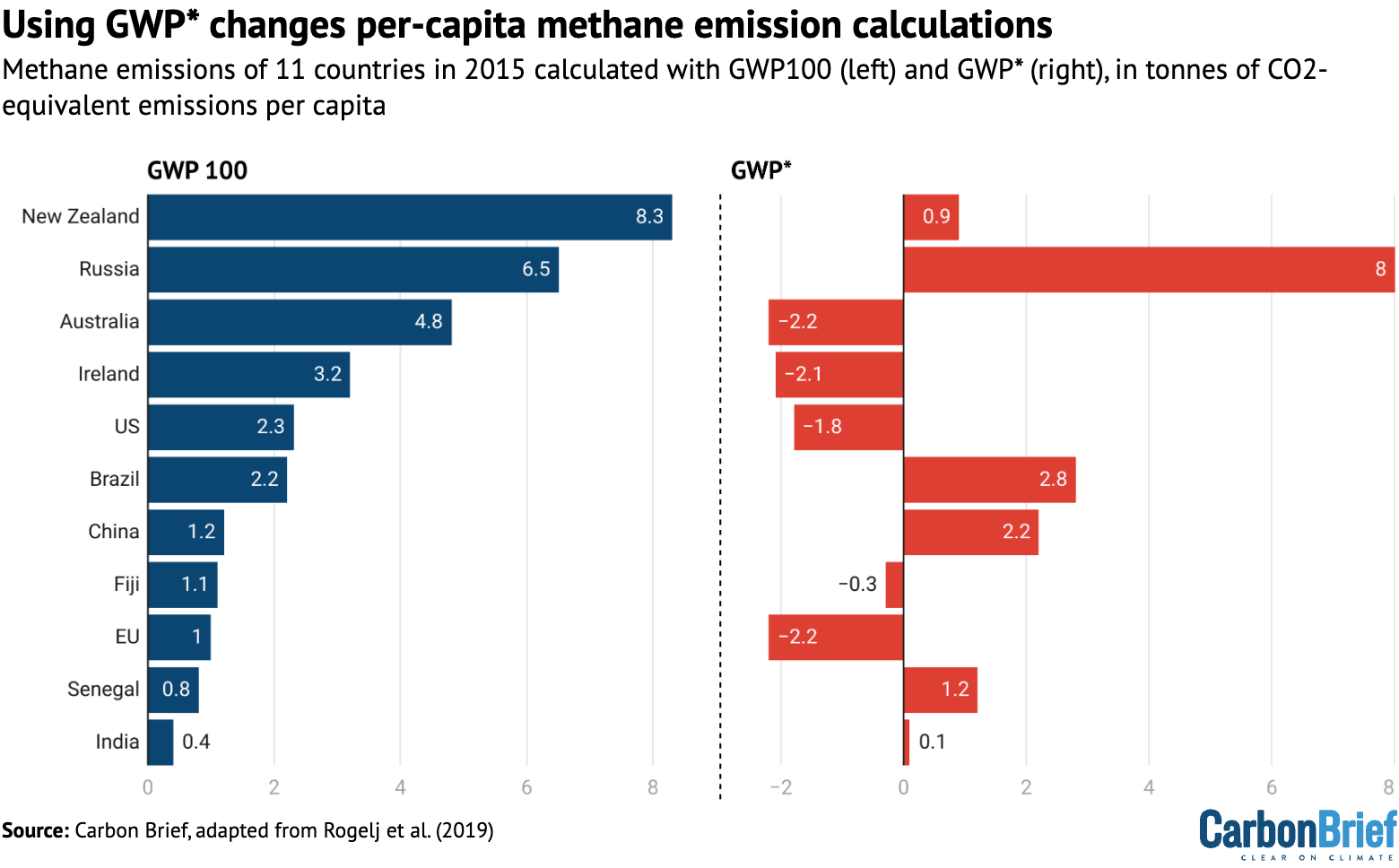
A 2025 study used a climate model to quantify future national warming contributions for Ireland under different emissions scenarios and found that “no additional warming” approaches, such as GWP*, are “not a robust basis for fair and effective national climate policy”.
Discussing baseline concerns, Allen says these considerations are the same for any other metric:
“It depends on how much account you want to take of [the] warming you’ve caused in the past – and at what point you want to take responsibility for the warming your actions had caused.”
He believes that most climate experts agree that it is good to understand the impact emissions have on global temperatures, but “where the controversy arises is about what you consider someone’s nominal emissions to be today”. He adds:
“This is where everybody gets upset, because if you use GWP*, then a livestock sector that’s reducing its emissions by 3% per decade – which most global-north livestock sectors are doing – it looks like their emissions are quite small.
“But that’s only a problem if you think that the main issue is working out whose fault global warming is, rather than working out what we should do about it.”
Communication
Many experts Carbon Brief spoke to took issue with how GWP* has been discussed by some of its proponents.
Murphy-Bokern criticises how Mitloehner and other experts communicate the metric. He says:
“The confusion arises from the activities of Mitloehner, in particular, where he presents the farming community – and the industry in general – with the idea that you can magic away the warming effect of methane simply by looking at the rate of change of methane emissions.”
Mitloehner says he has no regrets about his communication of GWP*, adding that he has “always emphasised to the livestock sector that reductions of methane are important”. He tells Carbon Brief:
“I’m proud because I have been able to take the livestock sector along with the understanding that reductions are needed and that they can be part of a solution if they understand that.”
The New York Times reported in 2022 that the research centre led by Mitloehner at the University of California, Davis “receives almost all its funding from industry donations and coordinates with a major livestock lobby group on messaging campaigns”. Other reports note his discussions about GWP* with stakeholders in various countries.
In response to these reports, Mitloehner says he believes it is important to work with the sector you are researching, adding that he receives both public and private funding. He tells Carbon Brief:
“The problem is not that they [the meat industry] are investing in research and communications and extension. The problem is that they are not putting in enough, because the public sector is withdrawing from this.
“Climate research is being slashed…If the government is not paying into research to quantify and reduce emissions – and those people who are critical of what we do say ‘oh, industry shouldn’t do it’ – then, I ask you, who should?”
Colin Woodall, the chief executive of the National Cattlemen’s Beef Association, a US lobby group, said in 2022 that GWP* is the “methodology we need to make sure everybody is utilising in order to tell the true story of methane”, Unearthed reported. According to the outlet, he added:
“We’re working with our partners around the globe to ensure that everybody is working towards adoption of GWP*.”
Asked if he regrets anything about his communication of GWP*, Allen tells Carbon Brief:
“When we first introduced this – and, perhaps, this is one thing I do regret – I was, perhaps, a little naive in that I thought everybody would seize on focusing on [the] warming impact because it was, from a policy perspective, potentially much easier for the agricultural sector.
“I thought that this would actually be welcomed. But, sadly, it’s not been. And I think part of that is because of this narrative of blame.”
Do any countries currently use GWP* to measure methane emissions?
GWP* is not yet used by any country in methane emission reporting or targets. But it has been considered by New Zealand, Ireland and other nations with high agricultural emissions.
A 2024 statement from dozens of NGOs and environmental organisations called for countries and companies not to use GWP* in their greenhouse gas reporting or to guide their climate mitigation policies. They wrote:
“The risks of GWP* significantly outweigh the benefits.”
New Zealand
New Zealand is currently considering changing its biogenic methane target, including applying the “no additional warming” approach used in GWP*. If it does so, it could become the first country to adopt GWP*.
The nation is a major livestock producer and agriculture generates nearly half of all its greenhouse gas emissions.
The chart below shows that the agricultural sector is also responsible for more than 90% of the country’s methane emissions.
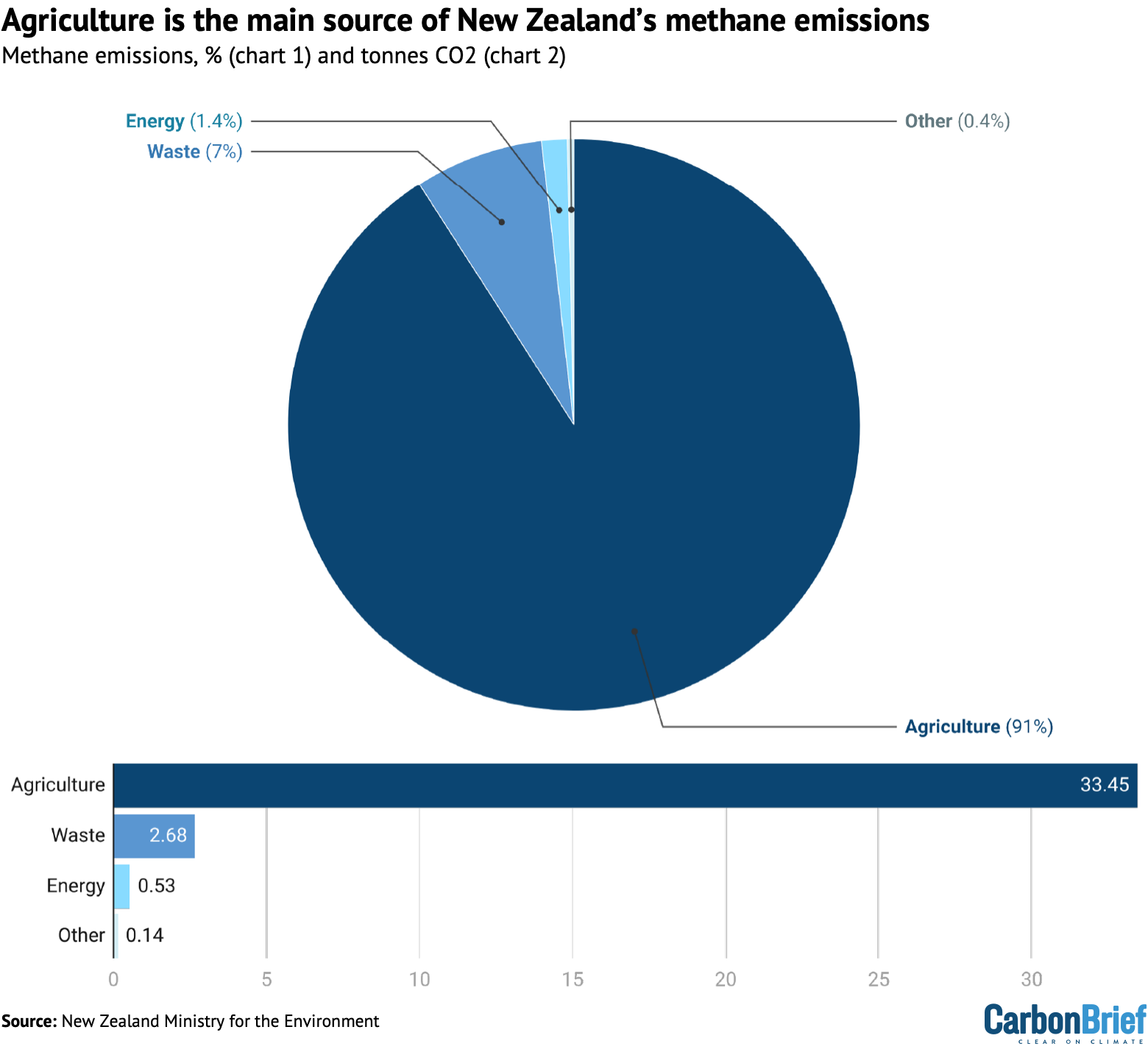
New Zealand has a legally binding target to reach net-zero greenhouse gas emissions by 2050. However, biogenic methane has separate targets to reduce by 10% by 2030 and by 24-47% by 2050, compared to a baseline of 2017 levels.
In late 2024, a review from the nation’s Climate Change Commission recommended that the government change its 2050 greenhouse gas targets, including to increase the biogenic methane goal to a 35-47% reduction by 2050.
At the same time, an independent panel commissioned by the New Zealand government reviewed how the country’s climate targets would look under the “no additional warming” approach.
The resulting report, which did not look specifically at GWP*, but used a similar concept, found that a 14-15% cut in biogenic methane by 2050 would be “consistent with meeting the ‘no additional warming’ condition”, under mid-range global emissions scenarios that keep temperatures below 2C.
The government is “currently considering” these findings, a spokesperson for the Ministry for the Environment tells Carbon Brief in a statement.
The spokesperson says that the report is “part of the body of evidence” that the government will use in its response to the Climate Change Commission’s review, which it must publish by November 2025.

Cain, the Cranfield University lecturer who co-created GWP*, wrote in Climate Home News in 2019 that New Zealand reducing biogenic methane by 24% would “offset the warming impact” of the rest of the country’s emissions, adding:
“New Zealand could declare itself climate-neutral almost immediately, well before 2050 and only because farmers were reducing their methane emissions. That’s a free pass to all the other sectors, courtesy of New Zealand’s farmers.”
A report on GWP* by the Changing Markets Foundation found that, in 2020, 16 industry groups in New Zealand and the UK “urged” the UN’s Intergovernmental Panel on Climate Change to use GWP* to assess warming impacts.
Australia
The Guardian reported in May 2024 that Cattle Australia, a cattle producer trade group, was “lobbying the red-meat sector to ditch its net-zero target in favour of a ‘climate-neutral’ goal that would require far more modest reductions in methane emissions”.
Cattle Australia’s senior adviser and former chief executive, Dr Chris Parker, tells Carbon Brief in a statement that the organisation is “working with the Australian government to ensure methane emissions within the biogenic carbon cycle are appropriately accounted for in our national accounting systems”. He adds:
“We believe GWP* offers a more accurate way of assessing methane’s temporary place in the atmosphere and its impact on the climate. Australian cattle producers are part of the climate solution and we need policy settings to enable them to participate in carbon markets.”
Australia’s Department of Climate Change, Energy, the Environment and Water did not respond to Carbon Brief’s request for comment.
Ireland
Internal documents assessed for the Changing Markets Foundation’s GWP* report “suggest” that Ireland’s Department of Agriculture, Food and the Marine has advocated for GWP* “at the international level”, including at the UN’s COP26 climate summit in 2021.
Allen and Mitloehner were involved in a 2022 Irish parliamentary discussion on methane, in which Allen advocated for the country to “be a policy pioneer” by using GWP* in its methane reporting alongside standard methods.
The country’s coalition government, formed earlier this year, pledged to “recognise the distinct characteristics of biogenic methane” and also “advocate for the accounting of this greenhouse gas to be re-classified at EU and international level”.
A spokesperson for Ireland’s Department of Agriculture, Food and the Marine tells Carbon Brief that this does not refer to using GWP* specifically. They say the country is “in favour of using accurate, scientifically validated and internationally accepted emission measurement metrics”, adding:
“It is important that the nature of how biogenic methane interacts in the environment is accurately reflected in how it is accounted for. This does not mean the use of the metric GWP*.”
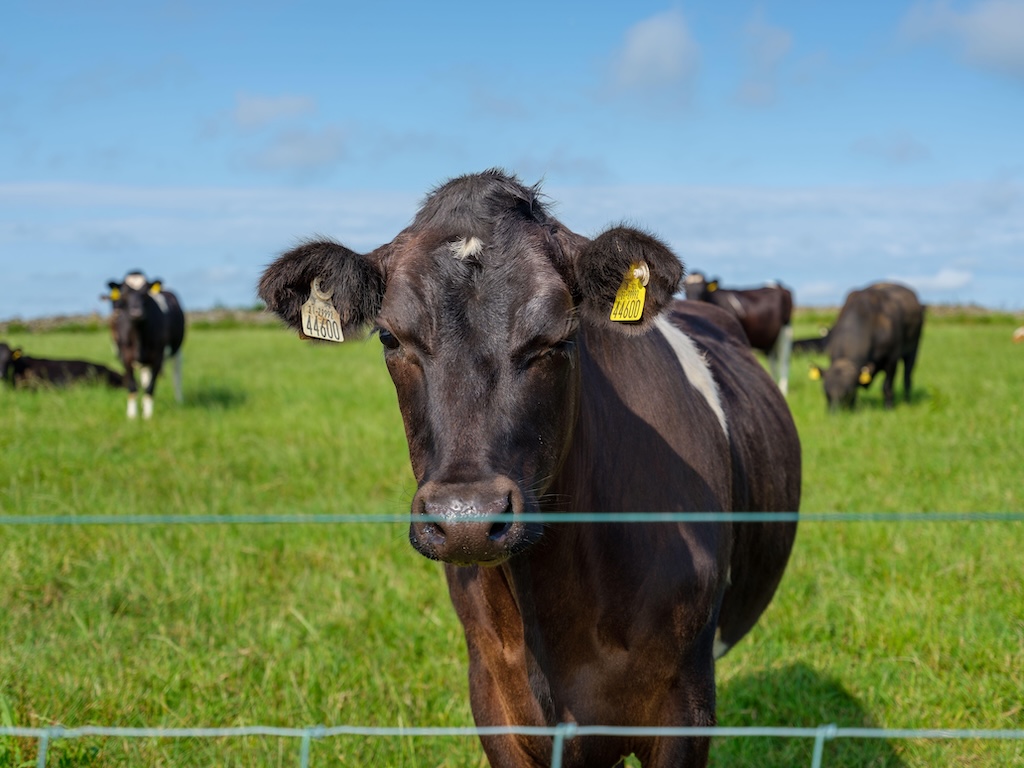
In December 2024, Ireland’s Climate Change Advisory Council proposed temperature neutrality pathway options to the government that do not specifically refer to GWP*, but use the same concept of no “additional warming”.
The Irish Times reported that this was “in part to reduce potential disruption from Ireland’s legal commitment to achieve national ‘climate neutrality’ by 2050”.
The climate and energy minister, Darragh O’Brien, said he has “not formed a definitive view” on this, the newspaper noted, and that expert views will feed into ongoing discussions on the 2031-40 carbon budgets, which are due to be finalised later in 2025.
In an Irish Times opinion article, Prof Hannah Daly from University College Cork, described the temperature neutrality consideration as “one of the most consequential climate decisions this government will make”. She wrote that the approach “amounts to a free pass for continued high emissions” of livestock methane.
Paraguay
Paraguay mentioned GWP* in a national submission to the UN in 2023 after agribusiness representatives “pushed” to adopt the metric, according to Consenso, a Paraguayan online newsletter.
The country’s National Directorate of Climate Change told Consenso for a separate article related to GWP* that it is “aware” of questions around the metric, but that it “has the option of using other measurement systems” for emissions reporting.
UK
The National Farmers’ Union, the main farming representative group in England and Wales, is in favour of using GWP* to measure agricultural methane emissions.
Carbon Brief understands that the UK government is not currently considering using GWP* in addition to, or instead of, GWP100 in its emissions reporting.
What do experts think about the use of GWP*?
Most experts Carbon Brief spoke to agreed that GWP* could be a useful metric to apply to global methane emissions, but that it is difficult to apply equitably in individual countries or sectors. Rogelj believes that are are some contexts in which GWP* could be used, but adds:
“You cannot just take targets that were set and discussed historically with one greenhouse gas metric in mind – GWP100 under the UNFCCC [United Nations Framework on Climate Change] and the Paris Agreement and all that – [and] then simply apply a different metric to it. They change meaning entirely.
“So, if one would like to use GWP*, one should build the policy targets and frameworks from the ground up to take advantage of the strengths of that metric, but also put in place safeguards that ensure that the weaknesses and limitations of that metric do not result in unfair or undesirable outcomes.”
A 2022 study says that using GWP* in climate plans “would ask countries to start from scratch in terms of their political target setting processes”, calling it a “bold ask” for policymakers.
It adds that achieving net-zero emissions, as measured with GWP*, “would only lead to a stabilisation of temperatures at their peak level”.
However, a 2024 study found that GWP* gives a “dynamic” assessment of the warming impact of emissions that “better aligns with temperature goals” than GWP100, when measuring methane emissions from agriculture.
Allen believes that criticism over the use of GWP* is similar to “saying it’s a meaningless question” to consider the warming impact of a country or company’s actions. He adds:
“That seems a very strange position to me, because we need to know how different activities are contributing to global warming because we have a temperature target.
“In saying GWP* is a bad thing, what people are actually saying is it’s a bad thing to know the warming impact of our actions, which is a very strange thing to say.”
He says that such metrics help countries to make informed decisions on climate action, but that “we can’t expect metrics to make these decisions for us”.
Murphy-Bokern notes that GWP* could be useful in modelling global, rather than national, methane emissions to avoid high-emitting countries making small methane cuts to achieve “no additional warming”, rather than significantly reducing these emissions.
He says the metric would be particularly useful if global emissions were close to zero, as a way to target the final remaining emissions. But, he adds:
“We are so far away from that very happy situation, that the discussion now with GWP* is a huge distraction from the key objective, which is to reduce emissions.”
Mitloehner – and every expert Carbon Brief spoke with – agrees with this wider point. He says:
“The main point is we need to reduce emissions. In the case of livestock, we need to reduce methane emissions. And the question is how do we get it done? And how do we quantify the impacts that [that reduction] would have accurately and fairly? The other issues are issues that politicians have to answer.”
The post Q&A: What the ‘controversial’ GWP* methane metric means for farming emissions appeared first on Carbon Brief.
Q&A: What the ‘controversial’ GWP* methane metric means for farming emissions
Greenhouse Gases
EAT-Lancet report: Three key takeaways on climate and diet change
A global shift towards “healthier” diets could cut non-CO2 greenhouse gas emissions, such as methane, from agriculture by 15% by 2050, according to a new report.
The EAT-Lancet Commission report on “healthy, sustainable and just food systems” says this diet would require producing more fruit, vegetables and nuts, as well as fewer livestock.
The findings build on the widely cited 2019 report from the EAT-Lancet Commission – a group of leading experts in nutrition, climate, economics, health, social sciences and agriculture from around the world.
The new report notes that one-third of all greenhouse gas emissions come from the global food system.
These emissions are so great that, even if all fossil fuels were phased out, “food can on its own push us beyond the 1.5C limit”, one of the commission co-chairs, Prof Johan Rockström, told a press briefing.
The report details a “planetary health diet” – a concept first introduced in the 2019 report – which focuses on “plant-rich” and “minimally processed” foods.
The latest edition builds on the previous report by adding improved modelling of food-system transformation and adding social-justice considerations.
The 2019 report faced a “massive online backlash” against some of its findings, particularly on cutting meat consumption, DeSmog reported earlier this year, which was “stoked by a PR firm that represents the meat and dairy sector”.
Rockström said the commission is “ready to meet that assault” if it arises again and issued concern “over this return of mis- and disinformation and denialism on climate science”.
Here, Carbon Brief picks out three key takeaways from the latest report.
- A ‘plant-rich’ diet has the best health and climate outcomes
- Transforming food systems could ‘substantially reduce’ the associated emissions
- Social justice should be a ‘central goal’ in transforming global food systems
A ‘plant-rich’ diet has the best health and climate outcomes
The new report recommends a plant-rich “planetary health diet”, which is largely the same as the one first outlined in the 2019 report.
The diet is designed to be flexible and “compatible with many foods, cultures, dietary patterns, traditions and individual preferences”, the report says.
It does not exclude meat or dairy products – the foods that cause the highest emissions – but recommends limited portions, equating to around one glass of milk per day and a couple of servings of meat and two eggs each week, for those whose diets include them.
The chart below outlines the recommended intake of different foods, adding up to around 2,400 calories each day. A range is given for each food type to accommodate different diets. The categories with the largest intakes include whole grains, plant oils, nuts and legumes.

The diet is “designed for health…[not] sustainability”, Dr Line Gordon, a commissioner on the report, told a press briefing.
But the report also analyses the climate impact of the recommendations. It estimates that shifting to the planetary diet could reduce global non-CO2 agricultural emissions – from greenhouse gases such as methane and nitrous oxide – by 15% by 2050. (See: Transforming food systems could ‘substantially reduce’ the associated emissions.)
Widespread adoption of the diet would require a two-thirds increase in fruit, vegetable and nut production and allow for a one-third reduction in livestock meat production, compared to 2020 levels.
Currently, diets across the globe all “deviate substantially” from the report’s recommendations. But the report claims that, due to the planetary diet’s health benefits, around 15 million “avoidable” deaths could be prevented each year if it were widely adopted.
The report also measures how much global food systems contribute to the nine planetary boundaries – a concept of global thresholds for a “safe and just” planet. It finds that food systems are the largest contributor to five breaches of these boundaries, which include changes in the use of land and freshwater.
In terms of steps to move towards the planetary diet, Gordon listed actions such as changing taxes to make healthy foods more affordable, clearly labelling foods and shifting agricultural production subsidies towards healthier foods.
The report highlights that “transforming food systems is not only possible, it’s essential to securing a safe, just and sustainable future for all”, Rockström says in a statement.
Transforming food systems could ‘substantially reduce’ the associated emissions
Food systems are responsible for about one-third of human-driven greenhouse gas emissions.
These emissions are roughly equally partitioned between livestock and crop production, land-use change and other aspects of the food system, including refrigeration, fertilisers, transport and retail, according to the report.
The authors use global economic models to determine how different actions towards transforming food systems could affect agricultural production, environmental impact and food prices.
For the baseline, they use a set of “business-as-usual” parameters. This scenario uses SSP2-7.0, a high-emissions pathway under which there is a global population of 9.6 billion people and global warming of 2C above pre-industrial temperatures in 2050.
Using these assumptions, the business-as-usual scenario results in a 37% increase in global agricultural production and a 33% rise in non-CO2 agricultural emissions by 2050, compared to 2020. Crop yields increase by nearly one-quarter in this scenario, while the amount of land used for agricultural cultivation expands by 2m square kilometres (km2) – an area roughly the size of Mexico.
The chart below shows the changes in non-CO2 agricultural emissions and agricultural land use under each scenario, with the three main scenarios highlighted in green. The dots indicate the results from different model runs.

The dietary transformation projection assumes a world in which there is total adherence to the suggested diet, a halving of food loss and waste and an additional 7-10% increase in global agricultural productivity.
They find that, in this scenario, agricultural emissions of non-CO2 greenhouse gases decline by 20% compared to 2020 values. Although cropland will have to expand to account for the increased intake of fruits, vegetables and legumes, the decrease in land needed for livestock-rearing means that agricultural land use will fall overall by 3.4m km2, an area the size of India.
The authors also consider a scenario that combines the dietary shifts with “ambitious mitigation” efforts. This includes policies such as carbon pricing and land-use regulations that could drive the adoption of bioenergy, afforestation and renewable energy, the report says.
Under widespread dietary shifts and ambitious mitigation, the report finds that non-CO2 emissions from agriculture will fall by 34% compared to 2020, and the reduction in agricultural land use will double compared to the scenario that only factors in the dietary shifts.
Social justice should be a ‘central goal’ in transforming global food systems
In a step further than its predecessor, the new report assesses justice in global food systems, by analysing the rights to food, a healthy environment and decent work.
The focus on social equity and justice added a “tremendous broader aspect” to the report, Dr Shakuntala Thilsted, one of the commission co-chairs, said in a briefing.
The report notes that more than half of the world’s population struggles to access healthy diets, which leads to “devastating consequences for public health, social equity and the environment”.
This primarily affects marginalised people living in low-income regions, it says.
The report finds that the diets of the world’s richest 30% of the population contribute to more than 70% of environmental pressures from food systems, such as land use and greenhouse gas emissions. The report says:
“These statistics highlight the large inequalities in the distribution of both benefits and burdens of current food systems.”
Furthermore, living and working in toxic-free environments and stable climate conditions is a “crucial” human right, it adds.
According to the report, “power asymmetries and discriminatory social and political structures” – such as the concentration of power among a small number of agribusiness firms – hinder the fulfilment of those rights.
The report says that social justice, along with environmental sustainability, should be central to global food systems.
It proposes several steps to making healthy, sustainable and just food systems more accessible by 2050: securing decent working conditions, ensuring liveable wages, recognising and protecting marginalised groups and limiting market concentration.

It notes that while taking steps to mitigate climate change will increase food costs – particularly in areas that currently do not consume adequate fruits and vegetables, and where animal-sourced food is less commonly eaten – some of these pressures can be alleviated by introducing subsidies targeted towards those preferred food groups.
Finally, the authors underscore that implementing this diet must consider both cultural context and sustainability.
However, they also warn that meeting these goals requires global action and “transformative change” in both individual and cultural habits.
The post EAT-Lancet report: Three key takeaways on climate and diet change appeared first on Carbon Brief.
EAT-Lancet report: Three key takeaways on climate and diet change
-
Climate Change2 years ago
Spanish-language misinformation on renewable energy spreads online, report shows
-
Climate Change Videos2 years ago
The toxic gas flares fuelling Nigeria’s climate change – BBC News
-
Climate Change2 months ago
Guest post: Why China is still building new coal – and when it might stop
-

 Greenhouse Gases1 year ago
Greenhouse Gases1 year ago嘉宾来稿:满足中国增长的用电需求 光伏加储能“比新建煤电更实惠”
-

 Climate Change1 year ago
Climate Change1 year ago嘉宾来稿:满足中国增长的用电需求 光伏加储能“比新建煤电更实惠”
-
Greenhouse Gases2 months ago
Guest post: Why China is still building new coal – and when it might stop
-

 Carbon Footprint1 year ago
Carbon Footprint1 year agoUS SEC’s Climate Disclosure Rules Spur Renewed Interest in Carbon Credits
-
Renewable Energy3 months ago
US Grid Strain, Possible Allete Sale

